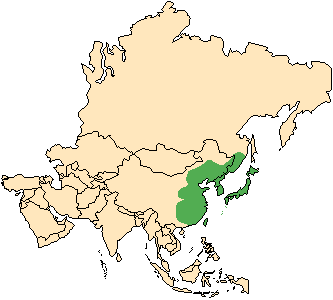![]() Return
to Artiodactyla
Return
to Artiodactyla
Classification
|
 Cervus nippon
Cervus nippon
Sika deer, Japanese deer
![]()
Taxonomy
 |
 |
 |
Click on the pictures above for a larger view of the
photographs
|
||
General Characteristics
Body Length: 105-155 cm / 3.5-5.1 ft.
Shoulder Height: 65-110 cm / 2.1-3.6 ft.
Tail Length: 10-20 cm / 4-8 in.
Weight: 25-110 kg / 55-242 lb.The colour of the coat ranges from grayish or chestnut brown to reddish olive, with the chin, belly, and throat being off-white. Some subspecies have a spattering of white spots on the upper sides, arranged in seven or eight lateral rows. These spots become less prominent in the winter as the coat grows shaggier, forming a dark mane on the neck, especially in males. On the rump, an erectile patch of light-coloured is used as a warning signal. The antlers, grown only in males, are narrow and erect with 2-10 tines on each bar, measuring 28-81 cm / 0.9-2.7 feet in length.
Ontogeny and Reproduction
Gestation Period: 217 days.
Young per Birth: 1, rarely 2
Weaning: At 8-12 months.
Sexual Maturity: At 18-24 months.
Life span: Over 10 years (15-20?)Mating takes place in September and October, with most births occurring in May and June.
Ecology and Behavior
Activity in the sika deer occurs mostly from dusk to dawn, though daytime activity is not unknown. Seasonal movements in Japan have been recorded, with winter ranges being up to 700 m / 2,300 vertical feet below the larger summer ranges. Sika deer are highly vocal, with over 10 individual sounds known, ranging from soft whistles to loud screams. Non-territorial males utilize a home range of about 11.74 hectares. During the summer, certain males begin to establish territories, 2.7-7.7 hectares in size, averaging 4.76 hectares (in Nara Park, Honshu, only one fifth of mature males exhibited territorial behaviour). The boundaries of these ranges are marked with urine and thrashing of the ground, and fiercely defended from other males, often with serious fighting with antlers and hoofs. Within his territory, a male will round up a harem of up to 12 females with which to mate.Family group: Usually solitary or in small groups.
Diet: Leaves, grasses.
Main Predators: Wolves.
Distribution
Variable habitats, including forests, marshes and grasslands, in Eastern Asia and Japan.

Range Map (Redrawn from Whitehead, 1993)
Conservation Status
The sika deer as a species has not been awarded a listing on the IUCN's Red List (1996). However, many sika subspecies do appear on the list. Both C. n. kopschi and C. n. sichuanicus are considered to be endangered, while C. n. grassianus, C. n. keramae, C. n. mandarinus, C. n. pseudaxis, and C. n. taiouanus are classified as critically endangered subspecies. C. n. aplodontus, C. n. mantchuricus, C. n. pulchellus, and C. n. yesoensis are data deficient.
Remarks
The sika deer is regarded as sacred in Japan. While many subspecies are in danger, the species as a whole is thriving, with numerous introduced populations in the British Isles, New Zealand, and the United States. Sika is Japanese for a small deer. Cervus (Latin) a stag, deer. Nippon (Japanese) Japan.
Literature Cited
Kurt, F. 1990. Sika deer (Subgenus Sika). In Grzimek's Encyclopedia of Mammals. Edited by S. P. Parker. New York: McGraw-Hill. pp. 174-175.Nowak, R. M. [editor]. 1991. Walker's Mammals of the World (Fifth Edition). Baltimore: The Johns Hopkins University Press.
Whitehead, K. G. 1993. The Whitehead Encyclopedia of Deer. Stillwater, MN: Voyageur Press, Inc.
Wilson, D. E., and D. M. Reeder [editors]. 1993. Mammal Species of the World (Second Edition). Washington: Smithsonian Institution Press. Available online at http://nmnhwww.si.edu/msw/
Return to Artiodactyla

![]()
© Brent Huffman, www.ultimateungulate.com |
|
|